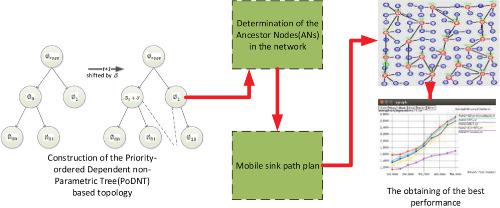当前位置:
X-MOL 学术
›
Int. J. Commun. Syst.
›
论文详情
Our official English website, www.x-mol.net, welcomes your
feedback! (Note: you will need to create a separate account there.)
A mobile sink path planning for wireless sensor networks based on priority‐ordered dependent nonparametric trees
International Journal of Communication Systems ( IF 1.7 ) Pub Date : 2020-05-08 , DOI: 10.1002/dac.4449 Sercan Yalçın 1 , Ebubekir Erdem 1
International Journal of Communication Systems ( IF 1.7 ) Pub Date : 2020-05-08 , DOI: 10.1002/dac.4449 Sercan Yalçın 1 , Ebubekir Erdem 1
Affiliation

|
The professional design of the routing protocols with mobile sink(s) in wireless sensor networks (WSNs) is important for many purposes such as maximizing energy efficiency, increasing network life, and evenly distributing load balance across the network. Moreover, mobile sinks ought to first collect data from nodes which have very important and dense data so that packet collision and loss can be prevented at an advanced level. For these purposes, the present paper proposes a new mobile path planning protocol by introducing priority‐ordered dependent nonparametric trees (PoDNTs) for WSNs. Unlike traditional clustered or swarm intelligence topology‐based routing methods, a topology which has hierarchical and dependent infinite tree structure provides a robust link connection between nodes, making it easier to reselect ancestor nodes (ANs). The proposed priority‐ordered infinite trees are sampled in the specific time frames by introducing new equations and hierarchically associated with their child nodes starting from the root node. Hence, the nodes with the highest priority and energy that belong to the constructed tree family are selected as ANs with an opportunistic approach. A mobile sink simply visits these ANs to acquire data from all nodes in the network and return to where it started. As a result, the route traveled is assigned as the mobile path for the current round. We have performed comprehensive performance analysis to illustrate the effectiveness of the present study using NS‐2 simulation environment. The present routing protocol has achieved better results than the other algorithms over various performance metrics.
中文翻译:

基于优先级排序的非参数树的无线传感器网络移动宿路径规划
无线传感器网络(WSN)中带有移动接收器的路由协议的专业设计对于许多目的都很重要,例如最大程度地提高能源效率,延长网络寿命以及在整个网络上平均分配负载平衡。此外,移动宿应该首先从具有非常重要和密集数据的节点收集数据,以便可以在更高级别上防止数据包冲突和丢失。出于这些目的,本文通过引入针对WSN的优先级排序的非参数树(PoDNT),提出了一种新的移动路径规划协议。与传统的基于集群或群体智能拓扑的路由方法不同,具有分层且依赖的无限树结构的拓扑在节点之间提供了可靠的链接连接,从而使重新选择祖先节点(AN)更加容易。通过引入新的方程式并在特定的时间范围内对提出的优先级排序的无穷树进行采样,并从根节点开始将其与子节点进行分层关联。因此,属于机会的方法将属于所构造的树族的具有最高优先级和能量的节点选择为AN。移动宿仅访问这些AN即可从网络中的所有节点获取数据,然后返回到其起点。结果,行进的路线被指定为当前回合的移动路径。我们进行了全面的性能分析,以证明使用NS-2仿真环境的当前研究的有效性。在各种性能指标上,本路由协议比其他算法获得了更好的结果。
更新日期:2020-05-08
中文翻译:

基于优先级排序的非参数树的无线传感器网络移动宿路径规划
无线传感器网络(WSN)中带有移动接收器的路由协议的专业设计对于许多目的都很重要,例如最大程度地提高能源效率,延长网络寿命以及在整个网络上平均分配负载平衡。此外,移动宿应该首先从具有非常重要和密集数据的节点收集数据,以便可以在更高级别上防止数据包冲突和丢失。出于这些目的,本文通过引入针对WSN的优先级排序的非参数树(PoDNT),提出了一种新的移动路径规划协议。与传统的基于集群或群体智能拓扑的路由方法不同,具有分层且依赖的无限树结构的拓扑在节点之间提供了可靠的链接连接,从而使重新选择祖先节点(AN)更加容易。通过引入新的方程式并在特定的时间范围内对提出的优先级排序的无穷树进行采样,并从根节点开始将其与子节点进行分层关联。因此,属于机会的方法将属于所构造的树族的具有最高优先级和能量的节点选择为AN。移动宿仅访问这些AN即可从网络中的所有节点获取数据,然后返回到其起点。结果,行进的路线被指定为当前回合的移动路径。我们进行了全面的性能分析,以证明使用NS-2仿真环境的当前研究的有效性。在各种性能指标上,本路由协议比其他算法获得了更好的结果。











































 京公网安备 11010802027423号
京公网安备 11010802027423号